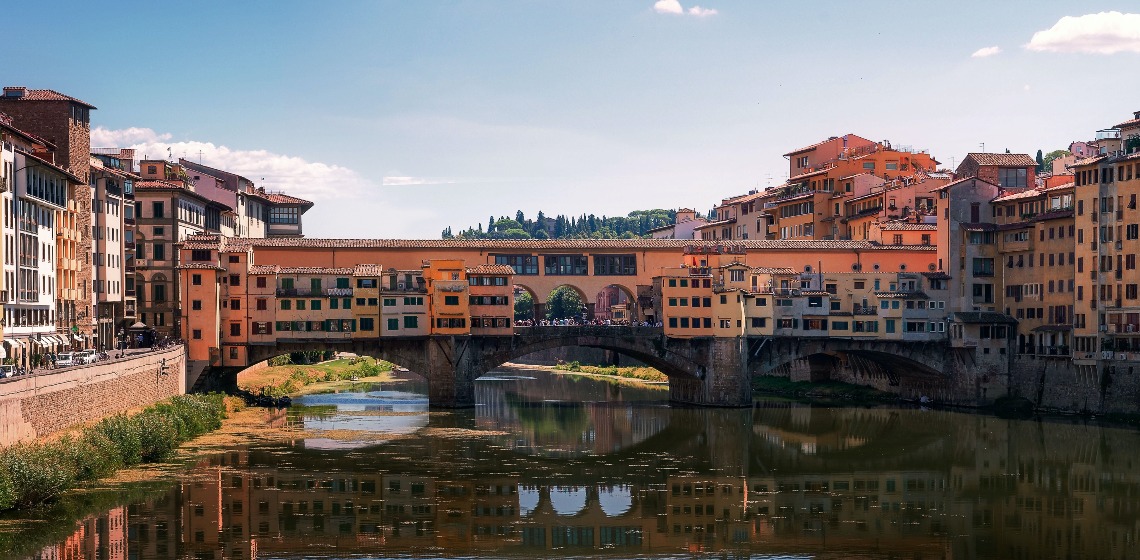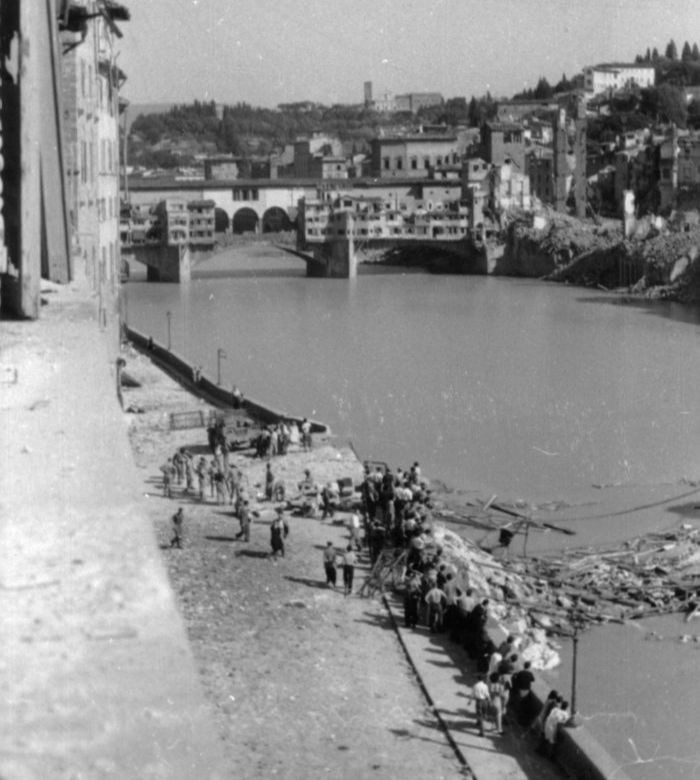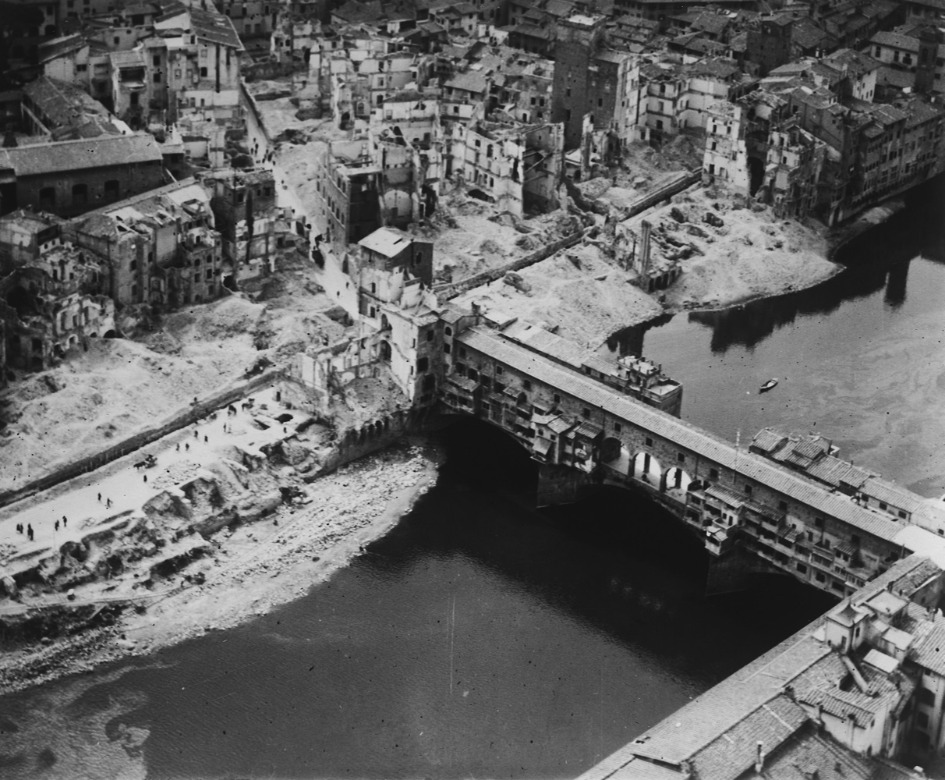
Who saved the Ponte Vecchio from Nazi bombs?
Was it the Nazis or an intriguing Florentine who saved the Ponte Vecchio from being bombed? Here lies the dilemma.
What is certain is that the Ponte Vecchio was spared on the night of August 3, 1944, the night when German troops blew up the bridges of Florence. It was undoubtedly a terrible event for Florence and the most painful of the occupation. There was also a night, however, that marked the turning point in the Florentine struggle for human rights, for the partisan force and for the end of the Nazi-fascist invasion.
At 6.45am on August 11 1944, Florence was awakened by the sound of Martinella, the most famous bell in Florence on the Arnolfo Tower in Palazzo Vecchio, which called its citizens to fight and to start the insurrection.

Photo credits: http://www.firenzewow.it/firenze-la-notte-dei-ponti-per-non-dimenticare-il-34-agosto-1944/
THE BATTLE OF FLORENCE
Thus began the heroic "Battle of Florence", following the destruction of its beloved bridges, which saw Florentines of all ages and social classes taking sides with the partisans with great courage and determination.
The Battle of Florence is recognized worldwide as a symbol of solidarity, strategy and resilience; 250 people lost their lives, there were more than 400 injured and nearly 150,000 displaced by the bombings on bridges. On September 1, 1944, Florence, thanks to its great strength and to the Comitato Toscano di Liberazione Nazionale (CTLN) (the first of its kind), Florence definitively freed herself from the invasion.
But the question remains: why was Ponte Vecchio saved?

Photo credits: https://firenzeurbanlifestyle.com/i-tesori-di-firenze-chi-ha-salvato-ponte-vecchio/
THE 2 THEORIES ABOUT WHO SAVED THE PONTE VECCHIO
- The Ponte Vecchio is too beautiful to be bombed.
The most famous, and perhaps the most romantic and cinematic theory, was also the only known theory until 2016 and which many still believe. The theory is that it was the Nazi troops, or even according to some, the Führer himself, who decided to save the Ponte Vecchio because of its artistic-cultural heritage. After all, Hitler's passion for art and the fact that only a few years earlier, on May 9, 1938, he had visited Florence accompanied by Mussolini, is well known.
Was the beauty of the Vasari corridor an Achilles' heel for Adolf Hitler?
Given that Florence is the city of Stendhal Syndrome, it would not be so absurd, but it certainly remains an Oscar night theory. However, there are many who stand by this story, adding the most realistic detail that Gerhard Wolf, the German consul in Florence at the time, was an extremely cultured and refined man and a huge admirer of Renaissance art and passionate about art history. In his years as a consul, he worked hard to safeguard Florentine cultural heritage. His presence was bound to have had an impact in the Ponte Vecchio question. - Burgasso saved his bridge.
Many Florentines were never convinced by the story that it was Hitler who spared the bridge. As rampant as he was, he had already bombed half of the city, could it be that the Renaissance softened him? For the many to whom this theory has always left doubts, the answer came in 2016. It was not Hitler, but Burgassi who saved it, known as Burgasso: crippled and ugly. The German troops had mistaken him for a poor wretched fool, thus granting him the freedom to roam the shops on the Ponte Vecchio where he knew all the goldsmiths.
Really, Burgasso was lucid and very intelligent, as Lucia Barocchi testifies in the book Of stone and gold: The Ponte Vecchio in Florence, seven centuries of history and art, published in 2016, in which all the secrets of the bridge were collected including that of Luciano, Burgasso's assistant in 1944. For years, he was loyal to Burgasso for fear of the consequences, until he felt obliged to rid himself of the weight of the secret in his later years, as recounted the book.
"Luciano, have we nothing to do for our poor Florence?"
This famous phrase was said by Burgasso to Luciano, but was always discredited by Germans as it was considered improbable. It is said that, before Luciano's eyes, the wires of the bombs were dismantled by Burgasso as he knew exactly where to find them: in via dè Ramaglianti, behind Borgo San Jacopo.

Photo credits: http://www.firenzewow.it/firenze-la-notte-dei-ponti-per-non-dimenticare-il-34-agosto-1944/






 All the services are provided by local merchants
All the services are provided by local merchants By using this site you support Florence
By using this site you support Florence We offer products with high-quality standards
We offer products with high-quality standards You stay sustainable
You stay sustainable It's a 100% trustworthy website
It's a 100% trustworthy website